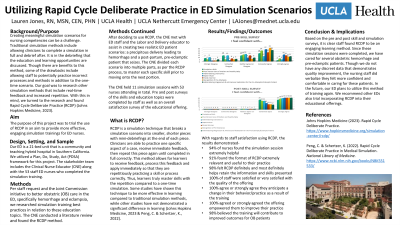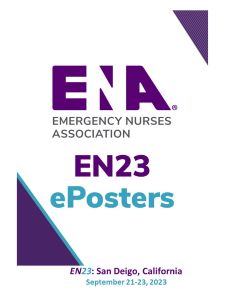Experience Hall
Utilizing Rapid Cycle Deliberate Practice in ED Simulation Scenarios
Friday, September 22, 2023
11:30 AM - 12:00 PM PST

Has Audio
- LJ
Lauren Jones, RN, MSN, CEN, PHN
Clinical Nurse Educator
UCLA Health
UCLA Health, Santa Monica
Santa Monica, California, United States
Aim: : The aim of this project was to trial the use of Rapid Cycle Deliberate Practice (RCDP) in an aim to provide more effective, engaging simulation trainings for ED nurses.
Framework:: We used a PDSA framework.
Setting:: Our ED is a 21-bed unit that is a community and teaching hybrid on the West Coast.
Stakeholder Team:: This project included the Clinical Nurse Educator (CNE) who researched simulation methods, created and ran the simulations, and who conducted and collated pre and post surveys.
Methods: : Per staff request and the Joint Commission initiative to better obstetric care in the ED, specifically to hemorrhage and eclampsia, we researched simulation training best practices in relation to these education topics. The CNE conducted a literature review and found the RCDP method. Per Johns Hopkins University, RCDP "is an innovative cognitive framework that uses simulation as the instructional tool, as well as the components of deliberate practice, mastery learning, and crisis resource management, to improve healthcare team performance during low-volume, high-risk, time-sensitive patient events". Compared to other simulation methods in which the learning takes place during the debriefing, RCDP provides real-time feedback to learners with repetitive practice of the correct actions. Thus, learners truly master skills with the repetition compared to a one-time simulation. For the low-volume, high-risk situations of this population, RCDP offers an effective method of training.
After deciding to use RCDP, the CNE met with ED staff and the labor and delivery educator to assist in creating two realistic ED patient scenarios- a precipitous delivery leading to hemorrhage and a post-partum, pre-eclamptic patient who then seizes. The CNE divided each scenario into multiple parts, as RCDP requires, to master each specific skill prior to moving onto the next portion.
The CNE held 11 simulation sessions with 53 nurses attending in total. Pre and post surveys of the skills and education topics were completed by staff as well as an overall satisfaction survey of the educational offering.
Outcomes:: As a result of utilizing the RCDP method of simulation- 94% of nurses found the simulation session extremely helpful; 91% found the format of RCDP extremely relevant and useful to their practice; 98% felt RCDP definitely and most definitely helps retain the information and skills presented; 100% of staff were satisfied or very satisfied with the quality of the offering; 100% agree or strongly agree they anticipate a change in their behavior/practice as a result of the training; 100% agreed or strongly agreed the offering empowered them to improve their practice; and 98% believed the training will contribute to improved outcomes for OB patients. In addition, there were very positive survey results regarding the specific education topics and equipment covered. All nurses reported feeling confident in the different topics and equipment in the post survey compared to the pre.
Implications:: Based on the pre and post skill and simulation surveys, it is clear staff found RCDP as an effective, engaging learning method. Our ED plans to utilize this method of training again, and we recommend other EDs also incorporate RCDP into their educational offerings.

